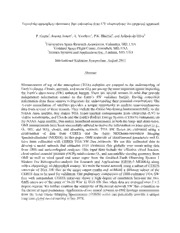
NASA Technical Reports Server (NTRS) 20120009058: Top-of-the-Atmosphere Shortwave Flux Estimation from UV Observations: An Empirical Approach PDF
Preview NASA Technical Reports Server (NTRS) 20120009058: Top-of-the-Atmosphere Shortwave Flux Estimation from UV Observations: An Empirical Approach
Top-of-the-atmosphere shortwave flux estimation from UV observations: An empirical approach i 3 2 2 P. Gupta , Joanna Joiner2, A. Vasilkov , P.K. Bhartia , and Arlindo da Silva iUniversities Space Research Association, Columbia, MD, USA 2Goddard Space Flight Center, Greenbelt, MD, USA 3Science Systems and Applications Inc., Lanham, MD, USA International Radiation Symposium, August 2012 Abstract Measurements of top of the atmosphere (TOA) radiation are essential to the understanding of Earth's climate. Clouds, aerosols, and ozone (0,) are among the most important agents impacting the Earth's short-wave (SW) radiation budget. There are several sensors in orbit that provide independent information related to the Earth's SW radiation budget. Having coincident information from these sensors is important for understanding their potential contributions. The A-train constellation of satellites provides a unique opportunity to analyze near-simultaneous data from several of these sensors. They include the Ozone Monitoring Instrument (OMI), on the NASA Aura satellite, that makes TOA hyper-spectral measurements from ultraviolet (UV) to visible wavelengths, and Clouds and the Earth's Radiant Energy System (CERES) instrument, on the NASA Aqua satellite, that makes broadband measurements in both the long- and short-wave. OMI measurements have been successfully utilized to derive the information on trace gases (e.g., 0 NO" and SO,), clouds, and absorbing aerosols. TOA SW fluxes are estimated using a 1, combination of data from CERES and the Aqua MODerate-resolution Imaging Spectroradiometer (MODIS). In this paper, OMI retrievals of cloud/aerosol parameters and 0 1 have been collocated with CERES TOA SW flux retrievals. We use this collocated data to develop a neural network that estimates TOA shortwave flux globally over ocean using data from OMI and meteorological analyses. This input data include the effective cloud fraction, cloud optical centroid pressure (OCP), total-column 0" and sun-satellite viewing geometry from OMI as well as wind speed and water vapor from the Goddard Earth Observing System 5 Modern Era Retrospective-analysis for Research and Applications (GEOS-5 MERRA) along with a climatology of chlorophyll content. We train the neural network using a subset of CERES retrievals of TOA SW flux as the target output (truth) and withhold a different subset of the CERES data to be used for validation. Our preliminary comparison of OMI-estimated TOA SW flux with independent CERES retrievals shows a high degree of correlation between the two. RMS errors are of the order of 10-20 Wm' in TOA SW flux when data are averaged over 2 x 2 degree regions. We further examine the sensitivity of the neural network SW flux estimation to the choice of input parameters. Application of our neural network to OMI heritage measurements from the Total Ozone Mapping Spectrometer (TOMS) series can potentially provide a unique term 1
